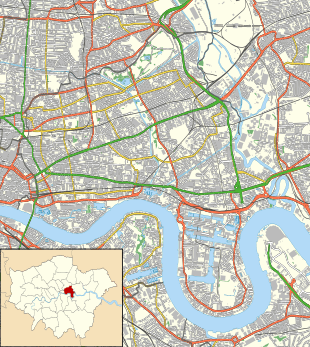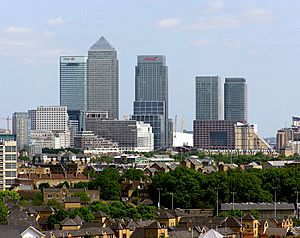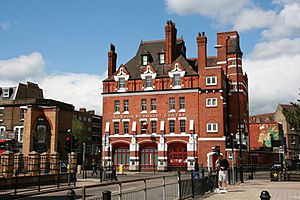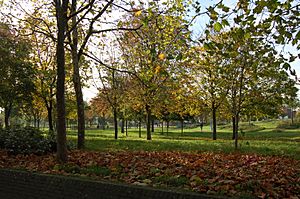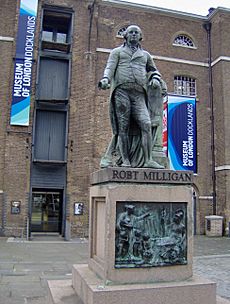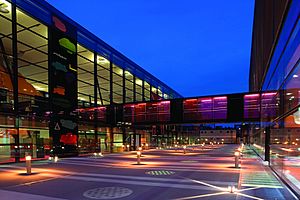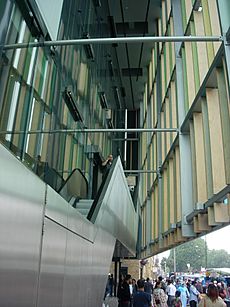London Borough of Tower Hamlets facts for kids
Quick facts for kids
Tower Hamlets
|
|||
|---|---|---|---|
|
|||
| Motto(s):
From Great Things to Greater
|
|||

Tower Hamlets shown within Greater London
|
|||
| Sovereign state | United Kingdom | ||
| Constituent country | England | ||
| Region | London | ||
| Ceremonial county | Greater London | ||
| Created | 1 April 1965 | ||
| Admin HQ | Clove Crescent, Blackwall | ||
| Government | |||
| • Type | London borough council | ||
| • Body | Tower Hamlets London Borough Council | ||
| Area | |||
| • Total | 7.63 sq mi (19.77 km2) | ||
| Area rank | 320th (of 326) | ||
| Population
(2020)
|
|||
| • Total | 324,745 | ||
| • Rank | 33rd (of 326) | ||
| • Density | 42,544/sq mi (16,426/km2) | ||
| • Ethnicity | 32% Bangladeshi 31.2% White British 12.4% Other White 3.7% Black African 3.2% Chinese 2.1% Black Caribbean 1.1% Black Caribbean & White 0.6% Black African & White 1.2% Asian & White 1.2% Other Mixed 2.7% Indian 1% Pakistani 2.3% Other Asian 1.5% Other Black 1% Arab 1.5% White Irish 0.1% White Gypsy or Irish Traveller 1.3% Other |
||
| Time zone | UTC (GMT) | ||
| • Summer (DST) | UTC+1 (BST) | ||
| Postcodes |
E, EC
|
||
| ONS code | 00BG | ||
| GSS code | E09000030 | ||
| Police | Metropolitan Police | ||
The London Borough of Tower Hamlets is a London borough covering much of the traditional East End. It was formed in 1965 from the merger of the former metropolitan boroughs of Stepney, Poplar, and Bethnal Green. 'Tower Hamlets' was originally an alternative name for the historic Tower Division; the area of south-east Middlesex, focused on (but not limited to) the area of the modern borough, which owed military service to the Tower of London.
The borough lies on the north bank of the River Thames immediately east of the City of London, and includes much of the redeveloped Docklands area. Some of the tallest buildings in London occupy the centre of the Isle of Dogs in the south of the borough. A part of the Queen Elizabeth Olympic Park is in Tower Hamlets.
The 2019 mid-year population for the borough is estimated at 324,745. Asian/Asian British Bangladeshis at 32% form the largest ethnic group. The 2011 census showed Tower Hamlets to have the highest proportion of Muslims of any English local authority and that Muslims outnumbered Christians. The borough has more than forty mosques and Islamic centres, including the East London Mosque, one of Britain's largest. Brick Lane's restaurants, neighbouring street market and shops provide the largest range of Bengali cuisine, woodwork, carpets and clothes in Europe. The Lane is also a major center of hipster subculture.
In 2017 a joint study by Trust for London and New Policy Institute found Tower Hamlets to be the 2nd most deprived London borough (after Barking and Dagenham) based on an average calculated across a range of indicators; with high rates of poverty, child poverty, unemployment and pay inequality compared to other London boroughs. However, it has the lowest gap for educational outcomes at secondary level.
The local authority is Tower Hamlets London Borough Council.
Contents
Geography
Physical geography
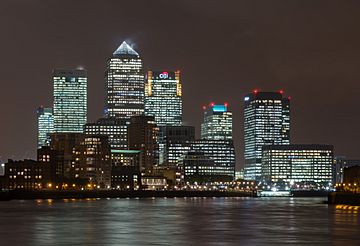
Tower Hamlets is located to east of the City of London and north of the River Thames in East London. The London Borough of Hackney lies to the north of the borough while the River Lea forms the boundary with the London Borough of Newham in the east. On the other side of the Thames is The London Borough of Southwark to the southwest, The London Borough of Lewisham to the South, and The Royal Borough of Greenwich to the southeast. The River Lea also forms the boundary between those parts of London historically in Middlesex, with those formerly in Essex.
The Isle of Dogs is formed from the lock entrances to the former West India Docks and the largest current meander of the River Thames and the southern part of the borough forms a part of the historic flood plain of the River Thames; and but for the Thames Barrier and other flood prevention works would be vulnerable to flooding.
The Regent's Canal enters the borough from Hackney to meet the River Thames at Limehouse Basin. A stretch of the Hertford Union Canal leads from the Regent's canal, at a basin in the north of Mile End to join the River Lea at Old Ford. A further canal, Limehouse Cut, London's oldest, leads from locks at Bromley-by-Bow to Limehouse Basin. Most of the canal tow-paths are open to both pedestrians and cyclists.
Victoria Park was formed by Act of Parliament, and administered by the LCC and its successor authority the GLC. Since the latter authority's abolition, the park has been administered by Tower Hamlets. Part of the borough is within the boundary of the Thames Gateway development area.
Areas within the borough
Areas included in the borough:
- Aldgate (also partly within the City of London)
- Bethnal Green
- Blackwall
- Bow
- Bow Common
- Bromley-by-Bow
- Cambridge Heath
- Canary Wharf
- Docklands
- East Smithfield
- Fish Island
- Globe Town
- Hackney Wick (also partly within the London Borough of Hackney)
- Isle of Dogs
- Cubitt Town
- Millwall
- Leamouth
- Limehouse
- Mile End
- Old Ford
- Poplar
- Ratcliff
- Shadwell
- Spitalfields
- Stepney
- Wapping
- Whitechapel
History
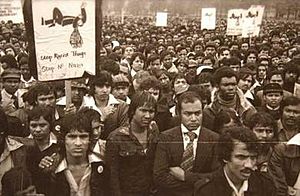
The earliest apparent use of the name "Tower Hamlets" was in the sixteenth century, when the Constable of the Tower of London commanded the Tower Hamlet Militia as the Lord Lieutenant of Tower Hamlets. The Hamlets of the Tower paid taxes for the militia in 1646.
The London Borough of Tower Hamlets forms the core of the East End. It lies east of the ancient walled City of London and north of the River Thames. Use of the term "East End" in a pejorative sense began in the late 19th century, as the expansion of the population of London led to extreme overcrowding throughout the area and a concentration of poor people and immigrants in the districts that made it up. These problems were exacerbated with the construction of St Katharine Docks (1827) and the central London railway termini (1840–1875) that caused the clearance of former slums and rookeries, with many of the displaced people moving into the area. Over the course of a century, the East End became synonymous with poverty, overcrowding, disease and criminality.
The East End developed rapidly during the 19th century. Originally it was an area characterised by villages clustered around the City walls or along the main roads, surrounded by farmland, with marshes and small communities by the River, serving the needs of shipping and the Royal Navy. Until the arrival of formal docks, shipping was required to land goods in the Pool of London, but industries related to construction, repair, and victualling of ships flourished in the area from Tudor times. The area attracted large numbers of rural people looking for employment. Successive waves of foreign immigration began with Huguenot refugees creating a new extramural suburb in Spitalfields in the 17th century. They were followed by Irish weavers, Ashkenazi Jews and, in the 20th century, Bangladeshis. Many of these immigrants worked in the clothing industry. The abundance of semi- and unskilled labour led to low wages and poor conditions throughout the East End. This brought the attentions of social reformers during the mid-18th century and led to the formation of unions and workers associations at the end of the century. The radicalism of the East End contributed to the formation of the Labour Party and demands for the enfranchisement of women.
Official attempts to address the overcrowded housing began at the beginning of the 20th century under the London County Council. World War II devastated much of the East End, with its docks, railways and industry forming a continual target, leading to dispersal of the population to new suburbs, and new housing being built in the 1950s. During the war, in the Boroughs making up Tower Hamlets a total of 2,221 civilians were killed and 7,472 were injured, with 46,482 houses destroyed and 47,574 damaged. The closure of the last of the East End docks in the Port of London in 1980 created further challenges and led to attempts at regeneration and the formation of the London Docklands Development Corporation. The Canary Wharf development, improved infrastructure, and the Queen Elizabeth Olympic Park mean that the East End is undergoing further change, but some of its districts continue to contain some of the worst poverty in Britain.
Local landmarks
Historical landmarks
- Brick Lane
- Cable Street - site of the Battle of Cable Street
- Hawksmoor's Christ Church, Spitalfields
- Site of two historic Royal Mints
- Tower of London
- Tower Bridge
- Victoria Park
Modern landmarks
The Canary Wharf complex within Docklands on the Isle of Dogs forms a group of some of the tallest buildings in Europe. One Canada Square was the first to be constructed and is the second tallest in London. Nearby are the HSBC Tower, Citigroup Centres and One Churchill Place, headquarters of Barclays Bank. Within the same complex are the Heron Quays offices.
Climate
The data below were taken between 1971 and 2000 at the weather station in Greenwich, around 1 mile (1.6 km) south of the town hall, at Mulberry Place:
| Climate data for London (Greenwich) | |||||||||||||
|---|---|---|---|---|---|---|---|---|---|---|---|---|---|
| Month | Jan | Feb | Mar | Apr | May | Jun | Jul | Aug | Sep | Oct | Nov | Dec | Year |
| Record high °C (°F) | 14.0 (57.2) |
19.7 (67.5) |
21.0 (69.8) |
26.9 (80.4) |
31.0 (87.8) |
35.0 (95.0) |
35.5 (95.9) |
37.5 (99.5) |
30.0 (86.0) |
28.8 (83.8) |
19.9 (67.8) |
15.0 (59.0) |
37.5 (99.5) |
| Average high °C (°F) | 8.3 (46.9) |
8.5 (47.3) |
11.4 (52.5) |
14.2 (57.6) |
17.7 (63.9) |
20.7 (69.3) |
23.2 (73.8) |
22.9 (73.2) |
20.1 (68.2) |
15.6 (60.1) |
11.4 (52.5) |
8.6 (47.5) |
15.2 (59.4) |
| Average low °C (°F) | 2.6 (36.7) |
2.4 (36.3) |
4.1 (39.4) |
5.4 (41.7) |
8.4 (47.1) |
11.5 (52.7) |
13.9 (57.0) |
13.7 (56.7) |
11.2 (52.2) |
8.3 (46.9) |
5.1 (41.2) |
2.8 (37.0) |
7.5 (45.5) |
| Record low °C (°F) | −10.0 (14.0) |
−9.0 (15.8) |
−8.0 (17.6) |
−2.0 (28.4) |
−1.0 (30.2) |
5.0 (41.0) |
7.0 (44.6) |
6.0 (42.8) |
3.0 (37.4) |
−4.0 (24.8) |
−5.0 (23.0) |
−7.0 (19.4) |
−10.0 (14.0) |
| Average precipitation mm (inches) | 51.6 (2.03) |
38.2 (1.50) |
40.5 (1.59) |
45.0 (1.77) |
46.5 (1.83) |
47.3 (1.86) |
41.1 (1.62) |
51.6 (2.03) |
50.4 (1.98) |
68.8 (2.71) |
58.0 (2.28) |
53.0 (2.09) |
591.8 (23.30) |
| Average rainy days (≥ 1.0 mm) | 10.8 | 8.5 | 9.6 | 9.4 | 9.0 | 8.3 | 8.0 | 7.6 | 8.5 | 10.7 | 10.1 | 9.9 | 110.4 |
| Average snowy days | 4 | 4 | 3 | 1 | 0 | 0 | 0 | 0 | 0 | 0 | 1 | 3 | 16 |
| Average relative humidity (%) | 81.0 | 76.0 | 69.0 | 64.0 | 62.0 | 60.0 | 60.0 | 62.0 | 67.0 | 73.0 | 78.0 | 82.0 | 69.5 |
| Mean monthly sunshine hours | 49.9 | 71.4 | 107.1 | 159.8 | 181.2 | 181.0 | 192.1 | 195.1 | 138.9 | 108.1 | 58.5 | 37.4 | 1,480.5 |
| Source 1: Record highs and lows from BBC Weather, except August and February maximum from Met Office | |||||||||||||
| Source 2: All other data from Met Office, except for humidity and snow data which are from NOAA | |||||||||||||
| Climate data for London (Heathrow airport 1981−2010) | |||||||||||||
|---|---|---|---|---|---|---|---|---|---|---|---|---|---|
| Month | Jan | Feb | Mar | Apr | May | Jun | Jul | Aug | Sep | Oct | Nov | Dec | Year |
| Average high °C (°F) | 8.1 (46.6) |
8.4 (47.1) |
11.3 (52.3) |
14.2 (57.6) |
17.9 (64.2) |
21.0 (69.8) |
23.5 (74.3) |
23.2 (73.8) |
19.9 (67.8) |
15.5 (59.9) |
11.1 (52.0) |
8.3 (46.9) |
15.2 (59.4) |
| Average low °C (°F) | 2.3 (36.1) |
2.1 (35.8) |
3.9 (39.0) |
5.5 (41.9) |
8.7 (47.7) |
11.7 (53.1) |
13.9 (57.0) |
13.7 (56.7) |
11.4 (52.5) |
8.4 (47.1) |
4.9 (40.8) |
2.7 (36.9) |
7.4 (45.4) |
| Average precipitation mm (inches) | 55.2 (2.17) |
40.9 (1.61) |
41.6 (1.64) |
43.7 (1.72) |
49.4 (1.94) |
45.1 (1.78) |
44.5 (1.75) |
49.5 (1.95) |
49.1 (1.93) |
68.5 (2.70) |
59.0 (2.32) |
55.2 (2.17) |
601.7 (23.68) |
| Average rainy days (≥ 1.0 mm) | 11.1 | 8.5 | 9.3 | 9.1 | 8.8 | 8.2 | 7.7 | 7.5 | 8.1 | 10.8 | 10.3 | 10.2 | 109.6 |
| Mean monthly sunshine hours | 61.5 | 77.9 | 114.6 | 168.7 | 198.5 | 204.3 | 212.0 | 204.7 | 149.3 | 116.5 | 72.6 | 52.0 | 1,632.6 |
| Source: Met Office | |||||||||||||
Demographics
| Population census | ||
|---|---|---|
| Year | Pop. | ±% |
| 1801 | 130,871 | — |
| 1811 | 160,718 | +22.8% |
| 1821 | 195,941 | +21.9% |
| 1831 | 231,534 | +18.2% |
| 1841 | 275,250 | +18.9% |
| 1851 | 330,548 | +20.1% |
| 1861 | 410,101 | +24.1% |
| 1871 | 489,653 | +19.4% |
| 1881 | 569,205 | +16.2% |
| 1891 | 584,936 | +2.8% |
| 1901 | 578,143 | −1.2% |
| 1911 | 571,438 | −1.2% |
| 1921 | 529,114 | −7.4% |
| 1931 | 489,956 | −7.4% |
| 1941 | 337,774 | −31.1% |
| 1951 | 232,860 | −31.1% |
| 1961 | 195,883 | −15.9% |
| 1971 | 164,699 | −15.9% |
| 1981 | 139,989 | −15.0% |
| 1991 | 167,985 | +20.0% |
| 2001 | 196,121 | +16.7% |
| 2011 | 254,096 | +29.6% |
| 2016 | 304,900 | +20.0% |
| Note: | ||
By 1891, Tower Hamlets – roughly the ancient civil parish of Stepney – was already one of the most populated areas in London. Throughout the nineteenth century, the local population increased by an average of 20% every ten years. The building of the docks intensified land use and caused the last marshy areas in the south of the parish to be drained for housing and industry. In the north of the borough, employment was principally in weaving, small household industries like boot and furniture making and new industrial enterprises like Bryant and May. The availability of cheap labour drew in many employers. To the south, employment was in the docks and related industries – such as chandlery and rope making.
By the middle of the nineteenth century, the district now recognised as Tower Hamlets was characterised by overcrowding and poverty. The construction of the railways caused many more displaced people to settle in the area, and a massive influx of Eastern European Jews at the latter part of the nineteenth century added to the population growth. This migration peaked at the end of that century and population growth entered a long decline through to the 1960s, as people moved away eastwards to newer suburbs of London and Essex. The area's population had neared 600,000 around the end of the nineteenth century, but fell to a low of less than 140,000 by the early 1980s.
The metropolitan boroughs suffered very badly during World War II, during which considerable numbers of houses were destroyed or damaged beyond use due to heavy aerial bombing. This coincided with a decline in work in the docks, and the closure of many traditional industries. The Abercrombie Plan for London (1944) began an exodus from London towards the new towns.
This decline began to reverse with the establishment of the London Docklands Development Corporation bringing new industries and housing to the brownfield sites along the river. Also contributing was new immigration from Asia beginning in the 1970s. According to the 2001 UK Census the population of the borough is approximately 196,106. According to the ONS estimate, the population is 237,900, as of 2010.
Tower Hamlets has one of the smallest White British populations of any local authority in the United Kingdom. No ethnic group forms a majority of the population; a plurality of residents are white (45%), of which only 69% (from a total of 31% of the entire population) are indigenous White British. Asians form 41% of the population, of which 32% are Bangladeshi; which is the largest ethnic minority group in the borough. A small proportion are of Black African and Caribbean descent (7%), with Somalis representing the second-largest minority ethnic group. Those of mixed ethnic backgrounds form 4%, while other ethnic groups form 2%. The indigenous proportion was recorded as 31.2% in the 2011 UK Census, a decrease from 42.9% in 2001.
In 2018, Tower Hamlets had the lowest life expectancy and the highest rate of heart disease of all London boroughs, along with Newham.
Ethnicity
| Ethnic Group | 2001 | 2011 | ||
|---|---|---|---|---|
| Number | % | Number | % | |
| White: British | 84,151 | 43% | 79,231 | 31% |
| White: Irish | 3,823 | 2% | 3,863 | 2% |
| White: Gypsy or Irish Traveller | 175 | 0% | ||
| White: Other | 12,825 | 7% | 31,550 | 12% |
| White: Total | 100,799 | 51% | 114,819 | 45% |
| Asian or Asian British: Indian | 3,001 | 2% | 6,787 | 3% |
| Asian or Asian British: Pakistani | 1,486 | 1% | 2,442 | 1% |
| Asian or Asian British: Bangladeshi | 65,553 | 33% | 81,377 | 32% |
| Asian or Asian British: Chinese | 3,573 | 2% | 8,109 | 3% |
| Asian or Asian British: Other Asian | 1,767 | 1% | 5,786 | 2% |
| Asian or Asian British: Total | 75,380 | 38% | 104,501 | 41% |
| Black or Black British: African | 6,596 | 3% | 9,495 | 4% |
| Black or Black British: Caribbean | 5,225 | 3% | 5,341 | 2% |
| Black or Black British: Other Black | 921 | 0% | 3,793 | 1% |
| Black or Black British: Total | 12,742 | 6% | 18,629 | 7% |
| Mixed: White and Black Caribbean | 1,568 | 1% | 2,837 | 1% |
| Mixed: White and Black African | 789 | 0% | 1,509 | 1% |
| Mixed: White and Asian | 1,348 | 1% | 2,961 | 1% |
| Mixed: Other Mixed | 1,168 | 1% | 3,053 | 1% |
| Mixed: Total | 4,873 | 2% | 10,360 | 4% |
| Other: Arab | 2,573 | 1% | ||
| Other: Any other ethnic group | 2,312 | 1% | 3,214 | 1% |
| Other: Total | 2,312 | 1% | 5,787 | 3% |
| Black, Asian, and minority ethnic: Total | 95,307 | 49% | 139,277 | 55% |
| Total | 196,106 | 100.00% | 254,096 | 100.00% |
Religion
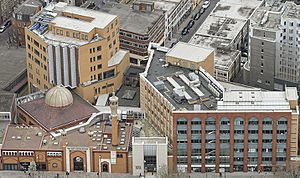
As Tower Hamlets is considered one of the world's most racially diverse zones, it holds various places of worship. According to the 2011 census, 34.5% of the population was Muslim, 27.1% Christian, 1.7% Hindu, 1.1% Buddhist, 1.1% followed another religions, 19.1% were not affiliated to a religion and 15.4% did not state their religion.
Tower Hamlets has the highest proportion of Muslims in England. There are more than 40 mosques and Islamic centres in Tower Hamlets. The most famous is the East London Mosque, one of the first mosques in Britain allowed to broadcast the adhan and one of the biggest Islamic centres in Europe. The Maryam Centre, a part of the mosque, is the biggest Islamic centre for women in Europe. Opened in 2013, it features a main prayer hall, ameliorated funeral services, education facilities, a fitness centre and support services. The East London Mosque has been visited by several notable people, including Prince Charles, Boris Johnson, many foreign government officials and world-renowned imams and Muslim scholars. Other notable mosques are Brick Lane Mosque, Darul Ummah Masjid, Esha Atul Islam Mosque, Markazi Masjid, Stepney Shahjalal Mosque and Poplar Central Mosque.
There are 21 active churches, affiliated with the Church of England, which include Christ Church of Spitalfields, St Paul's Church of Shadwell and St Dunstan's of Stepney and also churches of many other Christian denominations.
Other notable religious buildings include the Fieldgate Street Great Synagogue, the Congregation of Jacob Synagogue, the London Buddhist Centre, the Hindu Pragati Sangha Temple, and the Gurdwara Sikh Sangat.
Leisure
Parks in Tower Hamlets
There are over one hundred parks and open spaces in Tower Hamlets ranging from the large Victoria Park, to numerous small gardens and squares. The second largest, Mile End Park, separated from Victoria Park by a canal, includes The Green Bridge that carries the park across the busy Mile End Road. One of the smallest at 1.19 ha is the decorative Grove Hall Park off Fairfield Road, Bow, which was once the site of a lunatic asylum. Other parks include Altab Ali Park, Mudchute park and Grove Hall Park.
Museums
- Island History Trust
- Museum of London Docklands
- Ragged School Museum
- V&A Museum of Childhood
- Whitechapel Art Gallery
- The Women's Library
The Women's Library in Aldgate is the Great Britain's main library and museum resource on women and the women's movement, especially concentrating on Britain in the 19th and 20th centuries.
Transport
Road
As with most of the transport network in Tower Hamlets, several roads radiate across the Borough from the City of London. East–west routes include:
- the A11, which runs from Aldgate to the A12 near Stratford, passing through Whitechapel, Mile End, and Bow.
- the A13 (Commercial Road/East India Dock Road), which runs from Aldgate to Poplar. East of Poplar, the route continues towards Barking, Tilbury, and Southend.
- the A1203 (The Highway), which runs from Tower Hill, through Wapping, to Limehouse and Canary Wharf.
There are several north–south routes in the Borough, including:
- the A12, which begins at the A13 in Poplar and runs along the eastern edge of the Borough. The route carries traffic towards the M11 (for Stansted Airport
 ), Romford, and destinations in Essex, including Chelmsford and Harwich International Port. The route ultimately runs to Lowestoft in Suffolk.
), Romford, and destinations in Essex, including Chelmsford and Harwich International Port. The route ultimately runs to Lowestoft in Suffolk. - the London Inner Ring Road from Old Street to Tower Bridge.
There are three River Thames road crossings in the Borough. From west-east, these are:
- Tower Bridge (Tower Hill to Southwark and Bermondsey)
- Rotherhithe Tunnel (the A13 at Limehouse to Canada Water)
- Blackwall Tunnel (the A12 and A13 at Poplar to Greenwich)
Rail
The principal rail services commence in the City at Fenchurch Street, with one stop at Limehouse; and Liverpool Street, with stops at Bethnal Green and Cambridge Heath. The East London Line passes from north to south through Tower Hamlets with stations at Whitechapel, Shadwell and Wapping. One entrance to Shoreditch High Street station is inside the Borough. And the North London Line passes the very north in Tower Hamlets with one entrance to Hackney Wick inside the Borough. Two Crossrail stations are currently under construction and are expected to start services in summer 2021.
- Metro
The Docklands Light Railway was built to serve the docklands areas of the borough, with a principal terminus at Bank and Tower Gateway. An interchange at Poplar allows trains to proceed north to Stratford, south via Canary Wharf towards Lewisham, and east either via the London City Airport to Woolwich Arsenal or via ExCeL London to Beckton.
Three London Underground services cross the district, serving a total of 8 stations: the District and Hammersmith and City lines share track between Aldgate East and Barking. The Central line has stations at Bethnal Green and Mile End - where there is an interchange to the District line. A third central line station, at Shoreditch, has been proposed as the Central line runs within close proximity of Shoreditch High Street station. If built, it will be situated between the existing stations at Bethnal Green and Liverpool St. The Jubilee line has one stop at Canary Wharf.
List of stations
- Aldgate East station
- All Saints DLR station
- Bethnal Green railway station
- Bethnal Green tube station
- Blackwall DLR station
- Bow Church station
- Bow Road station
- Bromley-by-Bow station
- Cambridge Heath railway station
- Canary Wharf DLR station
- Canary Wharf tube station
- Crossharbour DLR station
- Devons Road DLR station
- East India DLR station
- Hackney Wick railway station
- Heron Quays DLR station
- Island Gardens DLR station
- Langdon Park DLR station
- Limehouse station (Rail and DLR)
- Mile End station
- Mudchute DLR station
- Poplar DLR station
- Shadwell railway station
- Shadwell DLR station
- Shoreditch High Street railway station
- South Quay DLR station
- Stepney Green tube station
- Tower Gateway DLR station
- Tower Hill tube station
- Wapping railway station
- West India Quay DLR station
- Westferry DLR station
- Whitechapel tube station
- Whitechapel railway station
In March 2011, the main forms of transport that residents used to travel to work were: underground, light rail, 24.0% of all residents aged 16–74; on foot, 7.5%; bus, minibus or coach, 7.5%; driving a car or van, 6.9%; bicycle, 4.1%; train, 3.8%; work mainly at or from home, 2.3%.
Tower Hamlets Borough Council operates a walking bus service for school pupils on agreed routes with some running every school day while and others once or twice a week depending on the number of adult volunteers involved.
Economy
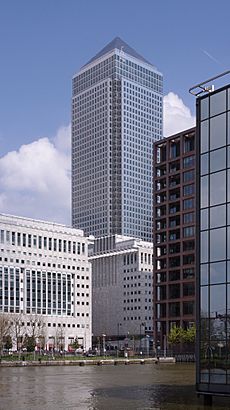

The borough hosts the world headquarters of many global financial businesses, employing some of the highest paid workers in London, but also has a high rates of long-term illness and premature death and the 2nd highest unemployment rate in London.
Canary Wharf is home to the world or European headquarters of numerous major banks and professional services firms including Barclays, Citigroup, Clifford Chance, Credit Suisse, Infosys, Fitch Ratings, HSBC, J.P. Morgan, KPMG, MetLife, Morgan Stanley, RBC, Skadden, State Street and Thomson Reuters. Savills, a top-end estate agency recommends that 'extreme luxury' and ultra-modern residential properties are to be found at Canary Riverside, West India Quay, Pan Peninsula and Neo Bankside.
The End Child Poverty coalition published that Tower Hamlets has the highest proportion of children in poverty of any local authority in the UK at 49% (and as high as 54.5% in the Bethnal Green South ward).
Surveys and interviews conducted by the Child Poverty Action group for the council found that the Universal Credit system was deeply unpopular with low-income families in the borough and that most claimants who have used the system found it difficult to understand and experienced frequent payment errors.
Sports
Mile End Stadium within Mile End Park hosts an athletics stadium and facilities for football and basketball. Two football clubs, Tower Hamlets F.C. (formerly Bethnal Green United) and Sporting Bengal United F.C., are based there, playing in the Essex Senior Football League.
John Orwell Sports Centre in Wapping is the base of Wapping Hockey Club. In 2014, the club secured over £300,000 of investment to designate the centre a hockey priority facility.
A leisure centre including a swimming pool at Mile End Stadium was completed in 2006. Other pools are located at St Georges, Limehouse and York Hall, in Bethnal Green. York Hall is also a regular venue for boxing tournaments, and in May 2007 a public spa was opened in the building's renovated Turkish baths.
KO Muay Thai Gym and Apolaki Krav Maga & Dirty Boxing Academy. in Bethnal Green are the main sources for martial arts and combat sports training in the area.
The unusual Green Bridge, opened in 2000, links sections of Mile End Park that would otherwise be divided by Mile End Road. The bridge contains gardens, water features and trees around the path.
Queen Elizabeth Olympic Park
Tower Hamlets was one of five host boroughs for the 2012 Summer Olympics; the Queen Elizabeth Olympic Park was constructed in the Lea Valley. As such, the borough's involvement in the Olympics includes:
- A small part of the Olympic Park is in Bow, a district of the borough, which makes the borough a host borough.
- The energy centre (King's Yard Energy Centre) of the Olympic Park is in the London Borough of Tower Hamlets, and gives energy to all the venues, none of which are located in Tower Hamlets.
- The world square and the London 2012 mega-store is also in the borough. The world square is for spectators, who can buy food or drink; the world's biggest McDonald's is in the world square in Tower Hamlets.
- The London 2012 mega-store provides official gifts and souvenirs. High Street, which is the main road to the Olympic park from west and central London, combines Whitechapel Road, Mile End Road and Bow Road.
- Victoria Park, in Tower Hamlets, is an important part of the Olympics because spectators without tickets can watch the games on big screens (London live 2012); that park is less than a mile away from the Olympic park. The main spectator cycle park is located in Victoria park. One of the entrances to the Olympic park is in Tower Hamlets, and is called the Victoria gate.
- A few schools in Tower Hamlets have taken part in the opening and closing ceremonies of the Olympic and Paralympic games as well as all the other host boroughs. The section of the Olympic Park in Tower Hamlets will be named "Sweetwater", one of the 5 new neighbourhoods after the games. Sweetwater will cover Tower Hamlets' part of the Olympic Park near Old Ford.
- The Olympic marathon was planned to run through the borough but later ran through the City and Westminster. However, the U-turn was located in the borough near The Tower of London.
- Danny Boyle, the artistic director of the London 2012 opening ceremony, lives in Mile End.
- A large number of Tower Hamlets' residents became Olympic volunteers; Tower Hamlets ranks second, after neighbouring borough Newham, for the number of volunteers from the borough.
Education
The London Borough of Tower Hamlets is the local education authority for state schools within the borough. In January 2008, there were 19,890 primary-school pupils and 15,262 secondary-school pupils attending state schools there. Independent-school pupils account for 2.4 per cent of schoolchildren in the borough. In 2010, 51.8 per cent of pupils achieved 5 A*–C GCSEs including Mathematics and English – the highest results in the borough's history – compared to the national average of 53.4 per cent. Seventy-four per cent achieved 5 A*–C GCSEs for all subjects (the same as the English average); the figure in 1997 was 26 per cent. The percentage of pupils on free school meals in the borough is the highest in England and Wales. In 2007 the council rejected proposals to build a Goldman Sachs-sponsored academy.
Schools in the borough have high levels of racial segregation. The Times reported in 2006 that 47 per cent of secondary schools were exclusively non-white, and that 33 per cent had a white majority. About 60 per cent of pupils entering primary and secondary school are Bangladeshi. 78% of primary-school pupils speak English as a second language.
The council runs several Idea Stores in the borough, which combine traditional library and computer services with other resources, and are designed to attract more diverse members. The flagship Whitechapel store was designed by David Adjaye and cost £16 million to build.
Universities
- Queen Mary University of London, a constituent college of the University of London, which includes Barts and The London, Queen Mary's School of Medicine and Dentistry
- London Metropolitan University
- UCL School of Management, located in One Canada Square, Canary Wharf
Further education colleges
- Tower Hamlets College, which in 2017 merged with Hackney Community College and Redbridge College to form New City College, the second largest college in London with over 20,000 students.
Schools and Sixth form colleges
- Bethnal Green Academy
- Bishop Challoner Catholic Collegiate School
- Bow School
- Central Foundation Girls' School
- George Green's School
- Lansbury Lawrence School
- Langdon Park School
- Morpeth School
- Mulberry School for Girls
- Oaklands School
- St Paul's Way Trust School
- Stepney All Saints School
- Stepney Green Maths, Computing & Science College
- Swanlea School, Business and Enterprise College
- Jamiatul Ummah School and Sixth Form
- London East Academy (East London Mosque)
- Ibrahim College
- London Enterprise Academy
- Wapping High School
- Mazahirul uloom London
Volunteering
- Volunteer Centre Tower Hamlets helps residents find volunteering work and provides support to organisations involving students volunteers.
Images for kids
See also
 In Spanish: Tower Hamlets para niños
In Spanish: Tower Hamlets para niños




